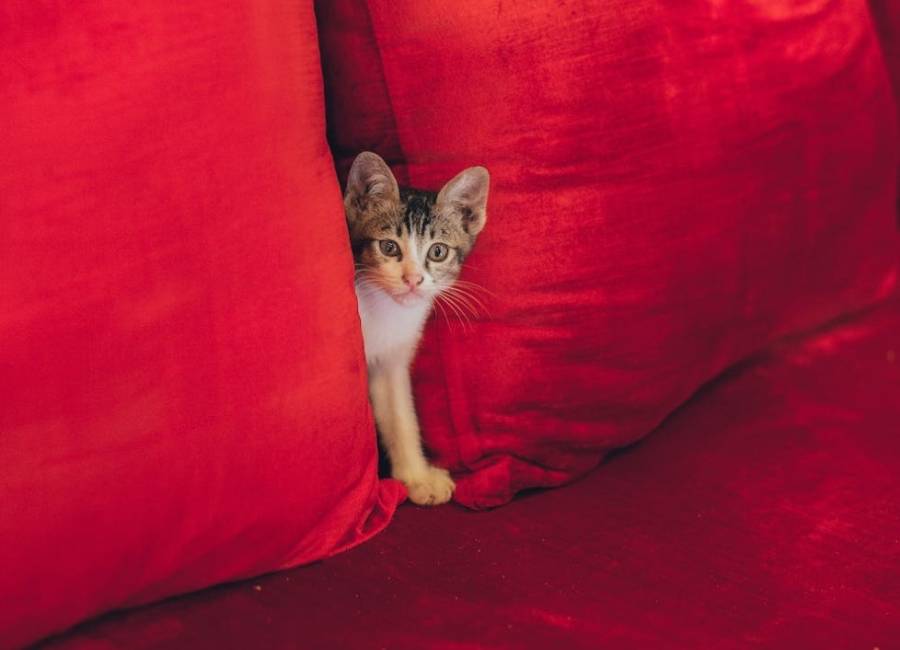10 Reasons for Your New Cat Hiding and Not Eating

You’ve been looking forward to having a new furry companion, and finally, you’ve brought home an adorable kitten.
But instead of playful meows and loving cuddles, all you’re getting is a nervous ball of fluff, hiding away and refusing to eat. Don’t worry – this is not uncommon behavior in new cats.
In this blog post, we’ll explore some reasons why your feline friend might be acting like this and suggest some ways to make them feel more comfortable in their new home.
So, let’s help you and your new cat start building a loving relationship filled with lots of purrs and snuggles!
Why is My New Cat Hiding and Not Eating
There could be several reasons why a new cat is hiding and not eating, and one common reason is stress related to moving to a new environment and being in a new place.
Signs of stress in a new cat can include decreased appetite, decreased grooming, and hiding. It is very common for a cat to stop eating for a short time due to the stress of moving to a new home.
Additionally, fear, anxiety, or illness can also cause a cat to refuse to eat and hide. If the hiding behavior and lack of appetite continue, it may be best to consult a veterinarian to ensure that there are no underlying health issues.
Some tips to help a new cat adjust include providing a quiet and comfortable environment, offering food and water, giving the cat space, and spending time gradually building a relationship with the cat through gentle and positive interactions.
Let’s break it down further…
Reasons For Your New Cat Hiding and Not Eating

The following are some of the most common reasons for your new cat hiding and not eating and what to do:
1. Stress and Anxiety
Cats often find moving to a new house to be stressful. They might experience stress or anxiety, which makes them hide and stop eating.
Create a calm, safe haven for your cat to retreat to, such as a separate room with their own food, water, and litter box, as well as calming objects like a blanket or their favorite toy, to help them feel less anxious.
One room at a time gradually introduces them to the rest of the house while giving them plenty of encouragement, patience, and assurance.
2. Lack of Familiar Scents
For comfort and security, cats place a lot of reliance on their sense of smell, this can contribute to your new cat’s hiding behavior if they don’t detect any familiar scents in their new surroundings.
Rub a soft cloth on their face gently to capture their scent before using it to lightly rub furniture or other items around the house. This will put them at ease and make them want to eat more.
3. Overwhelming Social Interactions
It’s important to spend quality time with your new cat, but too much social interaction can be stressful for them.
Allowing them to initiate play or cuddling sessions will allow you to give them space when they require it.
Maintain your respect for their boundaries while extending the time you spend with them.
When they exhibit signs of comfort and engagement, offer positive reinforcement like treats or soft praise.
Learn more about caring for a cat.
4. Lack of Confidence

Some cats are timid or lack self-confidence by nature, so it’s essential to gain their trust and confidence.
To reinforce desired behaviors, use positive reinforcement techniques like treats, compliments, and games.
Expose them to new situations and experiences gradually to help them conquer their fears.
By providing them with hiding places, climbing trees, and interactive toys that stimulate the mind, you can encourage them to explore.
5. Unappetizing Food
A cat’s appetite may change when they are in unfamiliar surroundings, and they may become picky eaters.
Try out various flavors and brands to determine which your cat prefers. Including both wet and dry food, offer a variety of textures.
Make sure there is always access to fresh water, and think about introducing wet food into their diet since the potent aroma can be more alluring.
To avoid digestive problems, gradually switch to their preferred food.
6. Litter Box Issues
Ineffective litter box placement or setup may discourage cats from using it, causing them to hide and avoid food.
Make sure the litter box is tidy, convenient, and situated in a quiet area.
Avoid placing the litter box in busy or noisy areas since cats prefer privacy when using it.
If you have a big house, provide multiple litter boxes and use litter that your cat is accustomed to using.
7. Illness or Pain
It’s important to take into account the possibility of an underlying health issue if your new cat hides and goes for an extended period of time without eating.
When they are ill, cats have an innate desire to hide, rule out any medical conditions, and make an appointment for a thorough examination at the vet.
If necessary, the veterinarian can administer the right care or medication, which might help them feel better and have more appetite.
8. Previous Traumatic Experience
Before entering your home, some cats might have gone through abuse or abandonment.
Their behavior and appetite may change as a result of these past experiences.
Gaining their trust requires patience and gentle interactions. Make sure there is peace and quiet and give them a private area to retreat to.
Avoid making loud noises or sudden movements that might make them fearful.
9. Adjustment to New Routine
Cats are creatures of habit, so any change in their routine can make them anxious and make them reluctant to eat.
Establish a regular schedule for feeding, playing, and socializing each day.
Your cat will feel secure and more inclined to eat frequently thanks to this predictability.
Put their water and food bowls in the same spot every day to foster familiarity.
10. Fear of New Environment
Cats can become fearful and hide if they encounter unfamiliar sights, sounds, or smells. Permit your cat to saunter around at their own pace.
To make them feel safe, give them places to hide, such as cat trees, boxes, or soft blankets.
Additionally, take into account using Feliway diffusers, which release artificial pheromones that give cats a sense of comfort and familiarity.
Make sure food and water are readily available for them in their hiding places to encourage eating.
Reasons why a new cat may be hiding

A new cat may be hiding because they need time to adjust to their new environment and assess whether it is safe or not.
Any change to a cat’s routine or environment can cause stress and anxiety, and hiding is a natural response for cats to feel safe and secure.
It is important to give them time to get comfortable with their new surroundings and not force them out of their hiding spot.
Additionally, some cats may simply have a timid personality and need more alone time where they can relax away from everything.
Learn more about socializing your cat.
Reasons why a new cat may not be eating
A new cat may not be eating due to the stress of the move to a new home, being in a new environment, and getting used to new surroundings.
They may also be frightened and need time to get used to the presence of their new owner.
Additionally, a new cat may not like the food being offered or may have an underlying health issue that is causing a lack of appetite.
It’s essential to monitor the cat’s behavior and consult with a veterinarian if the lack of appetite persists.
Learn more about cat lethargic not eating or drinking.
Steps to help a new cat feel comfortable and start eating

When bringing a new cat into your home, it is important to take steps to ensure they feel comfortable and start eating properly.
Here are some steps you can take to make this transition as smooth as possible:
- Give your new cat a quiet space: Your new cat may be overwhelmed during the first few days in your home, so it’s important to provide them with a quiet and comfortable space where they can feel safe. This could be a separate room with a litter box, food, and water bowls, and some toys.
- Introduce them to their litter box: Make sure your new cat knows where their litter box is located, and show them how to use it. It’s important to keep the litter box clean and accessible at all times.
- Offer them high-quality food: Offer your new cat high-quality cat food that they’ll enjoy. If possible, feed them the same food that they were given by their previous owner or shelter.
- Provide them with fresh water: Make sure your new cat has fresh water available at all times. You may want to consider purchasing a cat water fountain to encourage them to drink more water.
- Give them time to adjust: It’s important to give your new cat time to adjust to their new surroundings. Try not to overwhelm them with too much attention and allow them to come to you at their own pace.
- Provide them with toys: Provide your new cat with toys to play with, such as scratch posts and interactive toys. This will help keep them entertained and provide mental stimulation.
- Use pheromone sprays: Pheromone sprays can help reduce your cat’s stress levels and promote relaxation.
- Give them attention: Once your new cat has settled in, give them attention and affection. Spend time playing with them and petting them. This will help build trust and strengthen your bond.
- Schedule a visit with the vet: Schedule an appointment with the vet to make sure your new cat is healthy and up-to-date on all their vaccinations.
By following these steps, you can help your new cat feel comfortable and start eating properly in their new home.
Remember to be patient and give them plenty of love and attention, and they will soon feel like a member of your family.
Learn more about some common signs your new cat is adjusting.
Related Questions
How long can a cat go without eating?
It’s not uncommon for cats to go without eating for a day or two, but beyond that, it can be dangerous and can lead to more serious health concerns. If your cat has not eaten for more than 24 hours, you should take them to a vet.
How can I make my new cat feel more comfortable in their new home?
It’s important to give your new cat plenty of space and time to explore their new surroundings. Providing them with hiding spots and a quiet place to retreat to can help to ease their anxiety. You can also try offering them treats and toys to help them feel more relaxed.
What kind of food should I be offering my new cat?
If your new cat is not eating, it could be that they are not used to the food you’re offering. It’s ideal to offer them the same food that they were eating before you adopted them. If this is not possible, try to introduce them to their new food gradually by mixing it with their old food.
When should I start to worry about my cat not eating?
If your cat has not eaten for more than 24 hours, it’s time to take them to the vet. If left unaddressed, not eating can lead to serious health problems including liver disease and malnutrition.
What can I do to encourage my cat to eat?
If your cat is not eating, offering them different types of food or treats can sometimes help. It’s also important to make sure that they have access to plenty of water. If they still refuse to eat, it’s best to consult with a veterinarian to help determine the underlying cause and appropriate treatment.
Learn more about transitioning an outdoor cat to an indoor one.
Conclusion
Well, there you have it, folks! If your new cat is hiding and not eating, don’t panic just yet.
With patience, love, and these helpful tips, you can help your furry friend adjust to their new home and start living their best life.
Remember to give them their space, create a welcoming environment, and consult with a veterinarian if their behavior persists.
We hope you found these tips helpful and wish you and your furry friend all the best on your new journey together!
